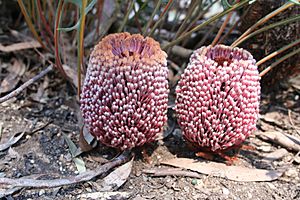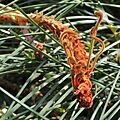Banksia blechnifolia facts for kids
Quick facts for kids Banksia blechnifolia |
|
|---|---|
 |
|
| Flower spikes in late bud, cultivated Australian National Botanic Gardens |
|
| Scientific classification | |
| Genus: |
Banksia
|
| Species: |
blechnifolia
|
 |
|
| Range of B. blechnifolia in green | |
Banksia blechnifolia is a type of flowering plant found in Western Australia. It belongs to the Banksia group of plants. This plant was first described in 1864 by a botanist named Ferdinand von Mueller. Its special name, blechnifolia, means "fern-leaved" because its leaves look a lot like fern leaves.
B. blechnifolia is a prostrate shrub, which means it grows low to the ground. It has stems that spread out horizontally and tough, upright leaves. Its flower spikes are reddish-brown and can grow up to 20 cm (8 in) tall. These flowers appear in the Australian spring, from September to November. As the flower spikes get older, they turn grey and can grow up to 25 woody seed pods.
Insects like bees, wasps, ants, and flies help pollinate the flowers. You can find B. blechnifolia growing in sandy soils near Lake King in the southern coastal part of Western Australia. This plant does not have a special woody base (called a lignotuber) that helps some plants regrow after a fire. Instead, it grows back from its seeds after a bushfire. It's also a good plant for gardens, especially in sunny spots with sandy soil. It works well in rock gardens or as a groundcover to spread across the ground.
Contents
What Does Banksia blechnifolia Look Like?
Banksia blechnifolia is a prostrate shrub that usually grows about 50 cm (20 in) high. It can spread out quite wide, from 2 to 4 m (7 to 13 ft) across. It has thick stems, up to 70 cm (28 in) long, that lie on the ground. These stems are covered in fine, rusty-brown fur when they are young, which turns grey as they get older.
The plant's tough leaves stand up straight from the stems. They are 25 to 45 cm (10 to 18 in) long and have 8 to 22 deep cuts or lobes along each edge. These lobes are shaped like narrow triangles. The leaves get narrower towards the top, ending in a point.
Flowers and Seeds
The flowers of Banksia blechnifolia appear from mid-September to late November. They grow in spikes, which are called inflorescences. These spikes can be up to 20 cm (8 in) tall and 9 cm (4 in) wide. They are usually reddish-brown or salmon-colored. Each individual flower is reddish-pink with a cream base, and they fade to light brown and then grey as they age.
After the flowers fade, they stay on the spike. Up to 25 furry, oval-shaped seed pods, called follicles, grow on the spike. These pods are about 2 to 3 cm (0.8 to 1.2 in) long. Inside these pods are the seeds. Each seed is about 2 to 2.5 cm (0.8 to 1.0 in) long and has a main body and a papery wing.
How Was Banksia blechnifolia Named?
The botanist Ferdinand von Mueller first wrote about Banksia blechnifolia in 1864. He used plant samples collected in 1861. The name blechnifolia comes from Blechnum, which is a type of fern, and folium, meaning "leaf." So, the name means "fern-leaved."
For a while, people thought this plant was the same as another species, Banksia repens. However, in 1981, Australian botanist Alex George confirmed that B. blechnifolia was its own unique species. He placed it in a group of Banksia plants that grow low to the ground, like this one. Scientists continue to study how B. blechnifolia is related to other plants using different methods, including looking at their DNA.
Where Does Banksia blechnifolia Grow?
Banksia blechnifolia is only found in Western Australia. It grows in the southern part of the state, between the towns of Jerramungup and Gibson, and also near Lake King. It likes to grow in flat areas with white sandy soils. You won't find it growing within 10 km (6 mi) of the coast.
How Does Banksia blechnifolia Survive in Nature?
Like many plants in southwestern Australia, Banksia blechnifolia is used to bushfires happening often. Most Banksia species either regrow from seeds after a fire (reseeders) or survive the fire and sprout new growth (resprouters).
B. blechnifolia is a "reseeder." This means that the fire kills the plant, but it also helps release its seeds. These seeds then grow into new plants, starting the next generation. Other low-growing Banksia species are often "resprouters," meaning they can survive fires.
Many insects help B. blechnifolia by pollinating its flowers. Bees, wasps, ants, and flies have all been seen visiting its flowers.
Can You Grow Banksia blechnifolia in a Garden?
Yes, Banksia blechnifolia is a good plant to grow in gardens, even outside of Western Australia. It is known to be strong against a plant disease called dieback.
People like to grow it because of its interesting fern-like leaves and its new growth, which often has a rusty color. It needs soil that drains water well, ideally sandy soil, but it can handle some clay. Giving it extra water when the weather is warm can help it grow strongly. Some cultivated plants can spread up to 4 m (13 ft) wide.
It makes a nice low-growing plant for covering ground, especially in rock gardens. However, it doesn't grow so thickly that it stops all weeds from growing around it, so adding mulch can help. It can also handle moderate frosts.
If you want to grow it from seeds, you don't need to do anything special to them. The seeds usually take between 14 and 49 days to sprout. Once planted, it takes about 4 to 5 years for B. blechnifolia to start flowering.
Images for kids
See also
 In Spanish: Banksia blechnifolia para niños
In Spanish: Banksia blechnifolia para niños




